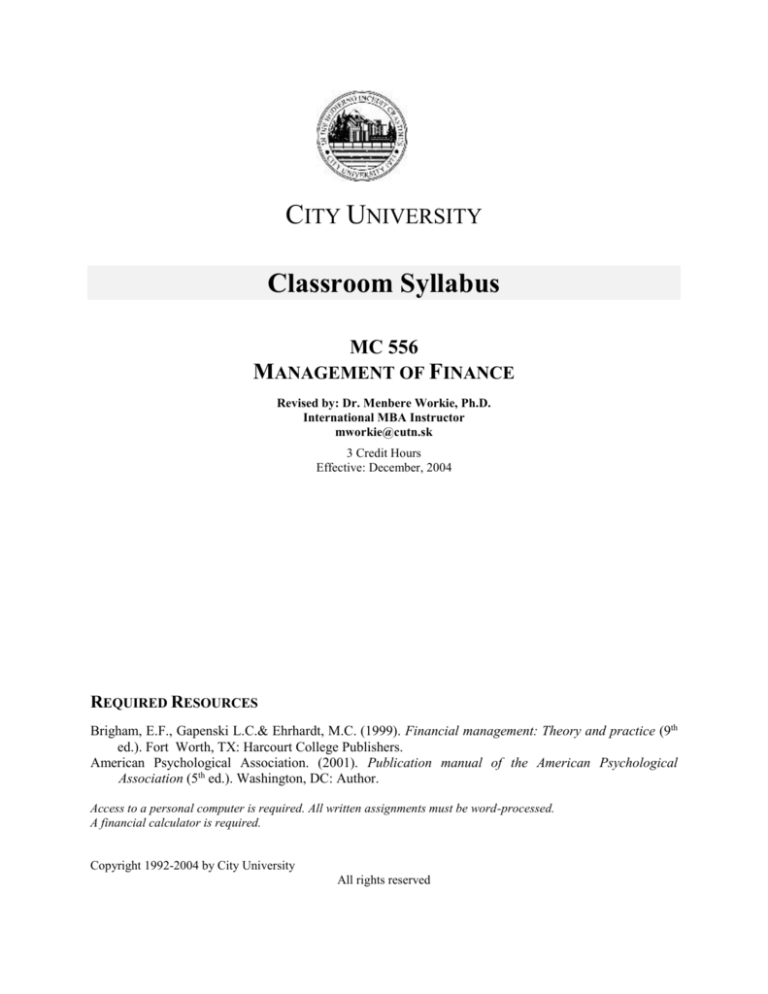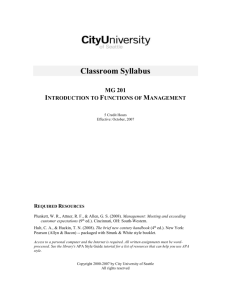
CITY UNIVERSITY
Classroom Syllabus
MC 556
MANAGEMENT OF FINANCE
Revised by: Dr. Menbere Workie, Ph.D.
International MBA Instructor
mworkie@cutn.sk
3 Credit Hours
Effective: December, 2004
REQUIRED RESOURCES
Brigham, E.F., Gapenski L.C.& Ehrhardt, M.C. (1999). Financial management: Theory and practice (9th
ed.). Fort Worth, TX: Harcourt College Publishers.
American Psychological Association. (2001). Publication manual of the American Psychological
Association (5th ed.). Washington, DC: Author.
Access to a personal computer is required. All written assignments must be word-processed.
A financial calculator is required.
Copyright 1992-2004 by City University
All rights reserved
MC 556
MANAGEMENT OF FINANCE
This document provides an overview of the course foundation elements, assignments, schedules and
activities. For information about general City University policies, please see the City University catalog.
If you have additional questions about the course, please contact your instructor.
Notification to Students with Disabilities
If you are a student with a disability and you require course adaptations or accommodations, please
contact the Affirmative Action Coordinator in the Disability Resource Office as soon as possible. You
may also contact your instructor or advisor for assistance.
COURSE DESCRIPTION
The management of finances of the firm includes capital budgeting, long-term and short-term financing,
current asset management, and leasing. The course also covers mergers, acquisitions, and divestitures, the
application of bankruptcy law and informal settlements to firms in financial distress, and some principles
of multinational financial management.
LEARNING GOALS
Upon the successful completion of this course, you will be able to:
1. Assess a firm’s performance in maximizing shareholder value by analyzing its financial results and
dividend policy;
2. Determine an optimal capital budget for a firm by evaluating estimated net cash flows and risks for
proposed projects.
3. Evaluate opportunities for long-term financing by comparing the alternatives of acquiring capital
through common stock, long-term debt, and various types of hybrid securities;
4. Develop effective plans for managing current assets—including cash, accounts receivable, and
inventory—using models, formulas, and other techniques;
5. Evaluate opportunities for short-term financing by comparing alternative sources and applications and
considering the advantages and disadvantages of short-term versus long-term financing;
6. Assess the advantages and disadvantages of leasing assets rather than buying them;
7. Analyze the consequences for firms in financial distress by comparing bankruptcy with informal
settlements;
8. Analyze the conditions for, process, and results of mergers, leveraged buyouts, and divestitures;
9. Compare and contrast multinational and domestic financial management;
MC 556
SYL
Page 2
Eff: 12/04
CORE CONCEPTS
To achieve the goals of this course, you will need to master the following core concepts:
1. Cash flow analysis and budgeting;
2. Risk analysis and real options;
3. Long-term financial planning;
4. Capital structure decisions;
5. Lease financing;
6. Distributions to shareholders;
7. Hybrid financing;
8. Current asset management;
9. Short-term financing;
10. Bankruptcy, reorganization, and liquidation;
11. Mergers, LBOs, and divestitures;
12. Risk and return on investment;
13. Time value of money;
14. Bonds and their valuation;
15. Stocks and their valuation;
16. Cost of capital;
17. Capital budgeting;
18. Financial leverage.
PROGRAM OVERVIEW
Finance is a major function within most organizations today. Managers who are responsible for
maximizing the value of the organizations they run must make financial decisions that enhance that value.
This course builds on the student’s prior knowledge of the basics of finance and financial management. In
combination with the MBA core courses and with other finance courses in the MBA curriculum, it is
designed to give students a broad understanding of financial management in different types of
organizations.
ENTRY COMPETENCIES
A prerequisite for enrolling in this course is completion of MC 553 (Principles of Finance), or evidence of
an equivalent knowledge of finance.
MC 556
SYL
Page 3
Eff: 12/04
RECOMMENDED SUPPLEMENTARY RESOURCES
As a City University student, you have access to library resources regardless of where you are taking this
class. For more information, click on “Library” at the bottom of the City U web site (www.cityu.edu).
Get help from a librarian by e-mailing library@cityu.edu or calling 800.526.4269 (U.S.) or
425.709.3444.
Databases on many topics are available via the web page—many include full-text articles.
Articles not available online may be faxed or mailed to you.
Books-by-mail available within the U.S.—search our catalog online.
Interlibrary loan—get books and articles from other libraries.
Cooperative libraries in Vancouver (WA and BC), Spokane, Portland, Seattle, the Tri-Cities,
Lynnwood, Bremerton, Bellingham, Wenatchee, Victoria and Yakima provide in-person service
to City U students. This list is current as of summer, 2001. Contact the library for information on
the cooperative library nearest you.
PRINT RESOURCES
Brigham, E.F., Gapenski, L.C. and Ehrhardt, M.C. (1999). Study guide to accompany Financial
management: Theory and practice (9th ed.). Fort Worth, TX: Harcourt College Publishers.
ELECTRONIC RESOURCES
Textbook Web site
http://www.harcourtcollege.com/finance/theory
The following Internet resources may be of use to you in this course. Please be aware that Web addresses
may change from time to time. Consult your instructor if you have questions about electronic resources.
City University
http://www.cityu.edu
Financial news:
http://finance.yahoo.com
http://www.thestreet.com
http://money.cnn.com
Journal of Finance
http://www.cob.ohio-state.edu/dept/fin/journal/jof.htm
Textbook Web site
http://www.prenhall.com/emery
The Wall Street Journal Online
http://www.wsj.com
MC 556
SYL
Page 4
Eff: 12/04
OVERVIEW OF COURSE ACTIVITIES AND GRADING
The grade you receive for the course will be derived using City University’s decimal grading system,
based on the following:
Assignment
Case Analysis 1 (Mini Case: Chapter 13)
Case analysis 2 (Mini Case: Chapter 19)
Final Examination
TOTAL
25%
25%
50%
100%
EXPLANATION OF ASSIGNMENTS AND GRADING
CASE ANALYSES
Your instructor will provide both of the graded case assignments. You should treat them as problems
presented to you by your company’s top management for analysis and decision recommendations. Hence,
your paper should demonstrate the qualities of thorough and relevant research, logically sound analysis,
and focused professional writing. For each question about the case, clearly indicate which question you
are answering, and show all computations (where applicable) to support your conclusions. Where
assumptions must be made, state and justify them clearly. Your instructor may also give you some
guidance on the assumptions you should make.
Grading Criteria for Case Analyses
Demonstrated understanding of relevant course
concepts
Clarity of explanations
Completeness and accuracy of calculations
Logically supported conclusions
Professional presentation (including language
and format)
TOTAL
20%
20%
20%
25%
15%
100%
MC 556
SYL
Page 5
Eff: 12/04
ADDITIONAL REQUIREMENTS FOR ASSIGNMENTS
HOMEWORK ASSIGNMENTS
The course schedule includes a list of homework assignments from your textbook. Completing all
homework assignments will help ensure that you successfully master the concepts in this course. The best
way for you to gain a thorough understanding of the underlying concepts is to apply those concepts to
solving the problems. You should focus on the underlying principles, rather than on just memorizing the
information necessary to answer a question or solve a problem. A certain amount of memorizing is
necessary initially, but memorized facts and definitions alone will not allow you to learn the concepts
taught in this course
The homework assignments are not graded. After you complete them, select some from each chapter and
ask your instructor for the correct answers, in order to ensure that you are mastering the required skills. If
you are having problems, ask your instructor for assistance, and request answers to additional
assignments. The answers should be referred to only after you have completed the homework items to the
best of your ability, using all the resources available to you.
PROFESSIONAL PRESENTATION OF WRITTEN WORK
All assignments submitted for this course should be of professional quality. You should present each
paper in a format that would be appropriate for submitting to upper management.
This course requires that you use the American Psychological Association (APA) style in preparing any
written work where other sources are used. A recommended style guide is included in the “Required Text
and Materials” section. Refer to this style guide for proper format, referencing methods, and
bibliographic format. References should be cited for all facts, ideas, conclusions, and opinions not your
own.
A proper title page should preface all written assignments, unless the instructor prescribes other
requirements. Your work should be word-processed on white 8 1/2- by 11- inch paper and all narrative
portions should be double spaced. Pages should be numbered and calculations shown to support answers
where appropriate. Some assignments may require that your work be prepared on a computer spreadsheet.
EXAMINATIONS
Both examinations will be three hours, closed book. You will be allowed to use one 8 ½ - by 11-inch page
of notes in your own handwriting. Both sides of the page may be used. The page of notes must be turned
in with your examination.
You should be prepared to answer a variety of types of questions pertinent to the concepts covered in or
suggested by the course materials, assignments and activities. Your instructor may provide you with
additional information about the content, style, and grading criteria of exams in this course. Make sure
that you bring with you to the examination the type of calculator you will need to answer the quantitative
questions. When doing any calculations, show and label all work clearly, because you may receive partial
credit even if your final answer is incorrect.
MC 556
SYL
Page 6
Eff: 12/04
Scholastic Honesty
City University expects each student to do his/her own work. The University has "zero tolerance"
for cheating, plagiarism, unauthorized collaboration on assignments and papers, using "notes" during
exams, submitting someone else's work as one's own, submitting work previously submitted for another
course, or facilitating acts of academic dishonesty by others. The penalties are severe! A first offense can
result in a zero grade for the course and suspension from the University for a quarter; a second offense
can result in a zero grade for the course and suspension from the University for a year; a third offense can
result in expulsion from the University. The Policy and Procedures may be found at www.cutn.sk/SH
In addition to providing your work to the instructor for grading, you must also submit an electronic copy
for the City University archives (unless the work is specifically exempted by the instructor). You will not
receive a final grade until and unless you submit this electronic copy. The procedure for submitting work
to the archives is to upload it via the website www.cutn.sk/Upload. Files should include the cover page
of the work with the student name, instructor name, course name and number, and date. All files received
into the archives are submitted to www.TurnItIn.com for plagiarism checking.
MC 556
SYL
Page 7
Eff: 12/04
COURSE SCHEDULE
Homework abbreviations: Q = Questions; P = Problems
SESSION
TOPICS AND ASSIGNMENTS
READINGS
HOMEWORK
1
Capital structure decision: Extension
Chapter 16
No assignment
Distributions to Shareholders: Dividends and
Repurchases
2
Chapter 17
Q17-1, 17-2, P17-1,
17-2, 17-3
Issuing Securities, Refunding Operations, And Other Chapter 18
Topics
Q18-1, 18-2
P18-1, 18-2, 18-3
Lease Financing
3
4
&
Chapter 19
Q19-1, P19-1, 19-2,
19-3
Ch. 20
Q20-1, 20-2, 20-4,
P20-1, 20-5(a-c)
Hybrid Financing: Preferred Stock, Warrants,
And Convertibles
Current Asset Management
Chapter 21
Q 21-1, P21-1, 21-6,
21-7, 21-10
Option Pricing with Applications to Real Options
Chapter 24
Q24-1, P24-1,
P24-3
24-2,
Mergers, LBOs, Divestitures, and Holding Companies
Chapter 26
Q26-1, P26-1, 26-2,
26-3
Bankruptcy, Reorganization, and Liquidation
Chapter 25
No assignment
5
Chapter 27
No assignment
6
Multinational Financial Management
Both cases are due at the day of the final exam.
MC 556
SYL
Page 8
Eff: 12/04







